Endocytosis and recycling of the complex between CD23 and HLA-DR in human B cells
- PMID: 11454061
- PMCID: PMC1783243
- DOI: 10.1046/j.1365-2567.2001.01238.x
Endocytosis and recycling of the complex between CD23 and HLA-DR in human B cells
Abstract
The presentation of extremely low doses of antigen to T cells is enhanced by immunoglobulin E (IgE)-dependent antigen focusing to CD23, the low-affinity receptor for IgE, expressed on activated B cells. CD23 contains a C-type lectin domain in its extracellular sequence and a targeting signal for coated pits, required for endocytosis, in its cytoplasmic sequence. CD23 is non-covalently associated with the major histocompatibility complex class II antigen, human leucocyte antigen HLA-DR, on the surface of human B cells, but the fate of this complex following endocytosis is unknown. To answer this question we have labelled these proteins on the surface of RPMI 8866 B cells and traced their route through the cytoplasm. Endocytosis mediated by anti-CD23 antibodies (BU38 and MHM6) led to the loss of CD23 from the cells. Endocytosis mediated by an antibody to HLA-DR (CR3/43) or an antigen-IgE complex (NP-BSA-anti-NP IgE), however, led to recycling of the HLA-DR-CD23 complex to the cell surface on a time scale (3-6 hr) consistent with the recycling of HLA-DR in antigen presentation. Along the latter pathway CD23 label was observed in cytoplasmic organelles that resembled the 'compartments for peptide loading' or 'class II vesicles' described by previous authors. Two features of the recycling process may contribute to the efficiency of antigen presentation. Peptide exchange may be facilitated by the proximity of HLA-DR and antigen in peptide loading compartments of the endosomal network. The return of CD23 with HLA-DR to the cell surface may then help to stabilize specific B-cell-T-cell interactions, contributing to T-cell activation.
Figures

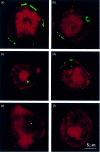
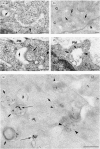
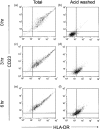
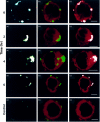
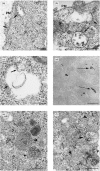
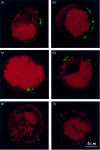
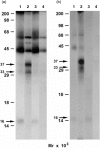
Similar articles
-
The low-affinity receptor for IgE (CD23) on B lymphocytes is spatially associated with HLA-DR antigens.J Exp Med. 1988 Jan 1;167(1):57-72. doi: 10.1084/jem.167.1.57. J Exp Med. 1988. PMID: 2961843 Free PMC article.
-
Surface-expressed invariant chain (CD74) is required for internalization of human leucocyte antigen-DR molecules to early endosomal compartments.Immunology. 1999 Mar;96(3):473-84. doi: 10.1046/j.1365-2567.1999.00676.x. Immunology. 1999. PMID: 10233730 Free PMC article.
-
A novel recycling mechanism of native IgE-antigen complexes in human B cells facilitates transfer of antigen to dendritic cells for antigen presentation.J Allergy Clin Immunol. 2018 Aug;142(2):557-568.e6. doi: 10.1016/j.jaci.2017.09.024. Epub 2017 Oct 23. J Allergy Clin Immunol. 2018. PMID: 29074459
-
Anti-CD23.Clin Rev Allergy Immunol. 2005 Aug;29(1):61-72. doi: 10.1385/CRIAI:29:1:061. Clin Rev Allergy Immunol. 2005. PMID: 16222084 Review.
-
Pairs of surface molecules involved in human IgE regulation: CD23-CD21 and CD40-CD40L.Eur Respir J Suppl. 1996 Aug;22:63s-66s. Eur Respir J Suppl. 1996. PMID: 8871046 Review.
Cited by
-
Preliminary Discovery of Small Molecule Inhibitors of Epidermal Growth Factor Receptor (EGFR) That Bind to the Extracellular Domain.Cancers (Basel). 2022 Jul 27;14(15):3647. doi: 10.3390/cancers14153647. Cancers (Basel). 2022. PMID: 35954311 Free PMC article.
-
High affinity targeting of CD23 inhibits IgE synthesis in human B cells.Immun Inflamm Dis. 2015 Jul 14;3(4):339-49. doi: 10.1002/iid3.72. eCollection 2015 Dec. Immun Inflamm Dis. 2015. PMID: 26732048 Free PMC article.
-
Beyond immediate hypersensitivity: evolving roles for IgE antibodies in immune homeostasis and allergic diseases.Immunol Rev. 2011 Jul;242(1):128-43. doi: 10.1111/j.1600-065X.2011.01024.x. Immunol Rev. 2011. PMID: 21682742 Free PMC article. Review.
-
A Mechanism for the Development of Chronic Traumatic Encephalopathy From Persistent Traumatic Brain Injury.J Exp Neurosci. 2019 May 20;13:1179069519849935. doi: 10.1177/1179069519849935. eCollection 2019. J Exp Neurosci. 2019. PMID: 31205424 Free PMC article.
-
The role of CD23 in the regulation of allergic responses.Allergy. 2021 Jul;76(7):1981-1989. doi: 10.1111/all.14724. Epub 2021 Jan 16. Allergy. 2021. PMID: 33378583 Free PMC article. Review.
References
-
- Yokota A, Kikutani H, Tanaka T, Sato R, Barsumian EL, Suemura M, Kishimoto T. Two species of human Fcε receptor II (FcεRII/CD23): tissue-specific and IL-4 specific regulation of gene expression. Cell. 1988;55:611–18. - PubMed
-
- Yokota A, Yukawa K, Yamamoto A, Sugiyama K, Suemura M, Tashiro Y, Kishimoto T, Kikutani H. Two forms of the low-affinity Fc receptor for the IgE differentially mediate endocytosis and phagocytosis: Identification of the critical cytoplasmic domains. Proc Natl Acad Sci USA. 1992;89:5030–4. - PMC - PubMed
Publication types
MeSH terms
Substances
LinkOut - more resources
Full Text Sources
Research Materials
Miscellaneous

